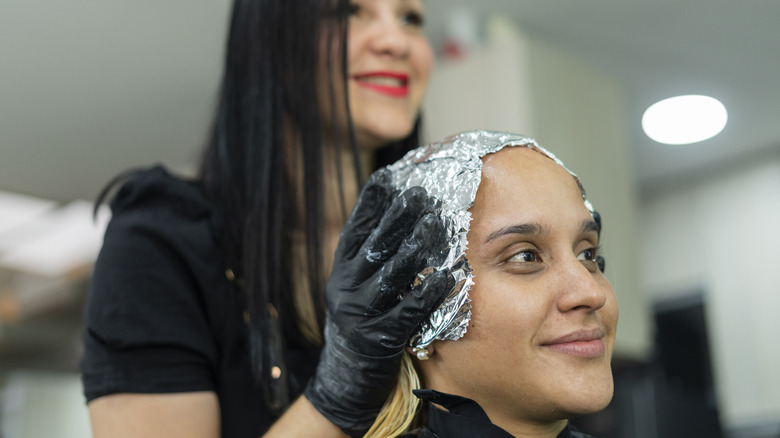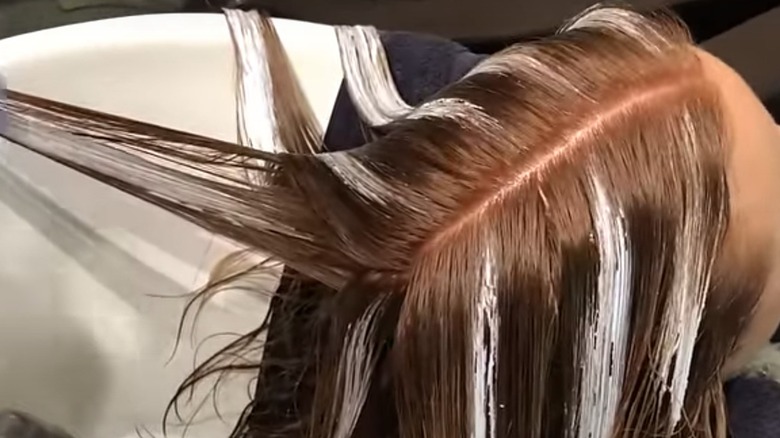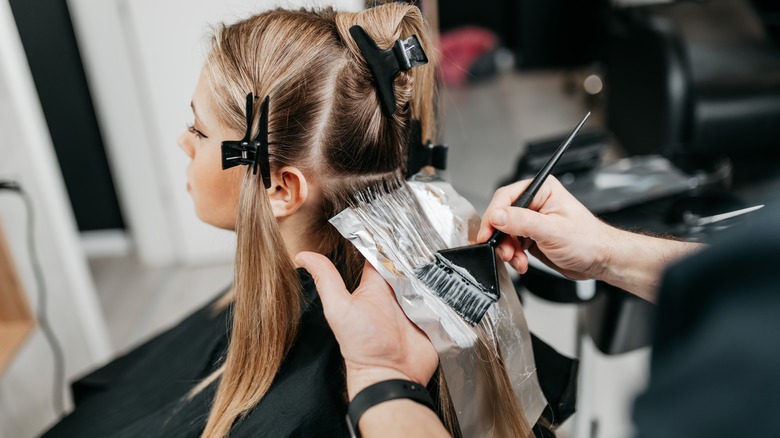The Big Benefit Of Bleaching Wet Hair, Not Dry
As the summer approaches, we take the cue from the warm days and want to add a touch of brightness to our hair, too. The beach calls for sun-kissed blond hair trends to try for 2024 and many of us can't wait to rock the bunny-blond hair trend, in particular. But what if we want to avoid super drastic changes to our coiffures?
Enter the technique of bleaching wet hair. Many hair colorists use the wet-hair bleaching technique for a subtler result. "When you don't want the hair to lift as much, bleaching [your hair while it is damp] can help you make a subtle [color] change to your hair," celebrity colorist and the co-founder of dpHUE Justin Anderson tells Byrdie. Why? The water reduces the effects of the bleach. So, if you are looking to slightly lighten your locks, the wet technique might be the one for you.
But there is another benefit of bleaching wet hair and it has to do with time! Bleaching wet hair is significantly faster than bleaching dry hair, even though the potency of the bleach is compromised. According to Anderson, "If you towel dry your hair and it is still damp, the bleach will act stronger since the hair cuticle is already open when it is wet."
Bleaching wet hair vs. bleaching dry hair
Aside from resulting in a subtler hair color lifting, bleaching wet hair also works a little bit differently than bleaching dry hair. To this end, Justin Anderson shares with Byrdie, "When your hair is dry, your colorist can isolate finer pieces, which is great for highlights, creating contrast, and color corrections." Meanwhile, colorist at Chicago's Maxine Salon Lauren Mildice tells the outlet, "Although this may take longer, bleaching dry hair allows you to use various techniques and placement strategies that damp hair does not." That said, bleaching wet hair is ideal when you want to add a bit of extra lightness at the ends of your strands or if you're looking for a less intense transformation.
In a Hair.com YouTube video, hair stylist Daniel Mason Jones explains how he uses both dry and wet balayage at his salon. With over 19 years of experience, he uses the two different methods to achieve different results. He reveals that wet balayage is one of his "very favorite things to do at the salon" because it gives an "amazing and blended" result, in a fraction of the time. The final look is "soft, gentle, [and] it literally took [Jones] about three minutes to paint."
In the video, he showcases how wet balayage is done. It happens right at the sink! Your hairstylist will wash your hair and will use a brush to apply the bleaching agent which will lift your hair's color. But since the hair is wet, the outcome won't be as intense. Even though in the video Jones vouches for the wet balayage service, it does have some potential risks involved, especially when not done by an expert hair colorist.
Are there any potential drawbacks to bleaching wet hair?
Blond is beautiful but bleach can burn. Unfortunately, bleaching wet hair can have some drawbacks, and negatively affect already thin, damaged, and brittle hair. According to dermatologist at the University of Utah Health Timothy Schmidt, M.D., "In general, wet hair is more fragile and prone to breakage than dry hair. The water weakens the hair's protein structure, making it more elastic and easier to stretch and snap." In other words, the protective shaft of each hair strand (known as the cuticle) weakens when wet, thus making your hair more susceptible to damage, even though the water does reduce the bleach's potency.
Moreover, water removes your hair's natural oils, which would normally work to protect against the damage from the bleach. As such, many hair colorists won't wet your hair completely or give it a thorough shampooing. Instead, they might dampen it slightly by spraying water on it with a spraying bottle (much like they do when they are about to give you a haircut).
As with all bleaching, it is imperative that your hairstylist does not leave the bleach on longer than necessary. Even a few minutes longer may result in your hair being excessively damaged, or you may even end up with less than optimal results. More specifically, the amount of lightening might not be the same across your entire head due to some strands being wetter than others, giving your hair a blotched appearance. So when deciding whether to request wet or dry bleaching, it's best to chat to your colorist and weigh up these pros and cons together.


